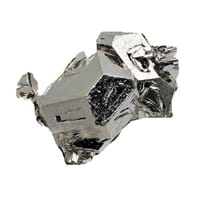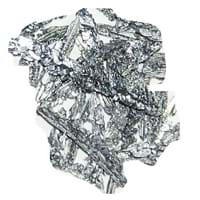Platinum Vanadium Comparison
Periodic Table
Symbol
Pt
V
Group Number
10
8
5
13
Period Number
6
4
Block
d block
d block
Element Family
Transition Metal
Transition Metal
CAS Number
7440064
99+
7440622
27
Space Group Name
Fm_ 3m
Im_ 3m
Space Group Number
225.00
2
229.00
1
Facts
Interesting Facts
- Platinum is the rarest metal from the Precious metal categories..
- Commercially Platinum is produced as a byproduct in ores of nickel.
- Vanadium is a highly reactive metal, hence it is not found free in nature.
- Vanadium can be found in almost 65 different types of minerals.
Sources
Mining, Ores of metals, Ores of Minerals
Found As a By-product, Found in Minerals, Mining, Ores of Minerals
History
Who Discovered
Antonio de Ulloa
Andrés Manuel del Río
Discovery
In 1735
In 1801
Abundance
Abundance In Universe
5 * 10-7 %
19
1 * 10-4 %
10
Abundance In Sun
~0.0000009 %
19
~0.00004 %
13
Abundance In Meteorites
0.00 %
25
0.01 %
14
Abundance In Earth's Crust
0.00 %
99+
0.02 %
12
Abundance In Oceans
Not Available
0.00 %
14
Abundance In Humans
Not Available
0.00 %
16
Uses
Uses & Benefits
- Platinum metal is mainly used in jewellery.
- Platinum is used as an industrial catalyst in production of nitric acid, silicone and benzene.
- Its ally with steel is used very tough and hence it is used in armor plates, axles, piston rods, tools and crankshafts.
- Its oxide is used as pigments for glass and ceramics.
Industrial Uses
Aerospace Industry, Chemical Industry
Aerospace Industry, Automobile Industry, Chemical Industry
Medical Uses
Dentistry, Pharmaceutical Industry, Surgical Instruments Manufacturing
NA
Other Uses
Alloys, Bullion, Coinage, Jewellery, Sculptures, Statues
Alloys
Biological Properties
Toxicity
Non Toxic
Toxic
Present in Human Body
No
Yes
In Blood
Not Available
0.00 Blood/mg dm-3
36
In Bone
Not Available
0.00 p.p.m.
31
Physical Properties
Melting Point
1,772.00 °C
16
1,890.00 °C
13
Boiling Point
3,827.00 °C
15
3,380.00 °C
20
Appearance
Physical State
Solid
Solid
Color
Silvery White
Blue-Silver Grey
Luster
Metallic
Metallic
Hardness
Mohs Hardness
3.50
11
6.70
4
Brinell Hardness
300.00 MPa
34
600.00 MPa
20
Vickers Hardness
400.00 MPa
25
628.00 MPa
17
Speed of Sound
2,800.00 m/s
29
4,560.00 m/s
17
Optical Properties
Reflectivity
73.00 %
8
61.00 %
14
Allotropes
No
No
α Allotropes
Not Available
Not Available
β Allotropes
Not Available
Not Available
γ Allotropes
Not Available
Not Available
Chemical Properties
Chemical Formula
Pt
V
Isotopes
Known Isotopes
35
4
22
17
Electronegativity
Pauling Electronegativity
2.28
3
1.63
20
Sanderson Electronegativity
Not Available
1.39
17
Allred Rochow Electronegativity
1.44
17
1.45
16
Allen Electronegativity
1.72
16
1.53
26
Electropositivity
Pauling Electropositivity
1.72
99+
2.37
34
Ionization Energies
1st Energy Level
870.00 kJ/mol
10
650.90 kJ/mol
99+
2nd Energy Level
1,791.00 kJ/mol
21
1,414.00 kJ/mol
99+
3rd Energy Level
Not Available
2,830.00 kJ/mol
35
4th Energy Level
Not Available
4,507.00 kJ/mol
25
5th Energy Level
Not Available
6,298.70 kJ/mol
23
6th Energy Level
Not Available
12,363.00 kJ/mol
5
7th Energy level
Not Available
14,530.00 kJ/mol
5
8th Energy Level
Not Available
16,730.00 kJ/mol
7
9th Energy Level
Not Available
19,860.00 kJ/mol
7
10th Energy Level
Not Available
22,240.00 kJ/mol
12
11th Energy Level
Not Available
24,670.00 kJ/mol
15
12th Energy Level
Not Available
29,730.00 kJ/mol
12
13th Energy Level
Not Available
32,446.00 kJ/mol
12
14th Energy Level
Not Available
86,450.00 kJ/mol
1
15th Energy Level
Not Available
94,170.00 kJ/mol
2
16th Energy Level
Not Available
102,300.00 kJ/mol
3
17th Energy Level
Not Available
112,700.00 kJ/mol
4
18th Energy Level
Not Available
121,600.00 kJ/mol
5
19th Energy Level
Not Available
130,700.00 kJ/mol
6
20th Energy Level
Not Available
143,400.00 kJ/mol
8
21st Energy Level
Not Available
151,440.00 kJ/mol
8
Electrochemical Equivalent
1.82 g/amp-hr
35
0.38 g/amp-hr
99+
Electron Work Function
5.65 eV
1
4.30 eV
18
Other Chemical Properties
Chemical Stability, Anti Corrosion, Ionization
Anti Corrosion, Ionization, Radioactive Isotopes
Atomic Properties
Atomic Number
78
38
23
99+
Electron Configuration
[Xe] 4f14 5d9 6s1
[Ar] 3d3 4s2
Crystal Structure
Face Centered Cubic (FCC)
Body Centered Cubic (BCC)
Crystal Lattice
FCC-Crystal-Structure-of-Platinum.jpg#100
BCC-Crystal-Structure-.jpg#100
Atom
Number of Protons
78
38
23
99+
Number of Neutrons
117
24
28
99+
Number of Electrons
78
38
23
99+
Radius of an Atom
Atomic Radius
139.00 pm
39
134.00 pm
99+
Covalent Radius
136.00 pm
99+
153.00 pm
33
Van der Waals Radius
175.00 pm
36
200.00 pm
28
Atomic Weight
47.87 amu
99+
50.94 amu
99+
Atomic Volume
9.09 cm3/mol
99+
8.78 cm3/mol
99+
Adjacent Atomic Numbers
Valence Electron Potential
392.42 (-eV)
1
120.00 (-eV)
6
Lattice Constant
392.42 pm
24
303.00 pm
99+
Lattice Angles
π/2, π/2, π/2
π/2, π/2, π/2
Lattice C/A Ratio
Not Available
Not Available
Mechanical Properties
Density
Density At Room Temperature
21.45 g/cm3
11
6.00 g/cm3
99+
Density When Liquid (at m.p.)
19.77 g/cm3
2
5.50 g/cm3
99+
Tensile Strength
125.00 MPa
14
800.00 MPa
6
Viscosity
Not Available
Not Available
Vapor Pressure
Vapor Pressure at 2000 K
0.07 (Pa)
18
0.23 (Pa)
16
Elasticity properties
Shear Modulus
61.00 GPa
14
47.00 GPa
16
Bulk Modulus
230.00 GPa
6
160.00 GPa
11
Young's Modulus
168.00 GPa
14
128.00 GPa
15
Poisson Ratio
0.38
6
0.37
7
Other Mechanical Properties
Ductile, Malleable
Ductile, Malleable
Magnetic Properties
Magnetic Characteristics
Specific Gravity
21.45
4
5.96
99+
Magnetic Ordering
Paramagnetic
Paramagnetic
Permeability
0.00 H/m
3
Not Available
Electrical Properties
Electrical Property
Conductor
Superconductor
Resistivity
105.00 nΩ·m
30
197.00 nΩ·m
19
Electrical Conductivity
0.10 106/cm Ω
21
0.05 106/cm Ω
35
Electron Affinity
205.30 kJ/mol
2
50.60 kJ/mol
20
Thermal Properties
Specific Heat
0.13 J/(kg K)
39
0.49 J/(kg K)
10
Molar Heat Capacity
25.86 J/mol·K
35
24.89 J/mol·K
99+
Thermal Conductivity
71.60 W/m·K
24
30.70 W/m·K
39
Critical Temperature
Not Available
Not Available
Thermal Expansion
8.80 µm/(m·K)
99+
8.40 µm/(m·K)
99+
Enthalpy
Enthalpy of Vaporization
510.50 kJ/mol
11
458.60 kJ/mol
14
Enthalpy of Fusion
19.70 kJ/mol
12
17.57 kJ/mol
14
Enthalpy of Atomization
565.00 kJ/mol
11
514.60 kJ/mol
13
Standard Molar Entropy
41.60 J/mol.K
36
28.90 J/mol.K
99+
|
||
|
||
|












